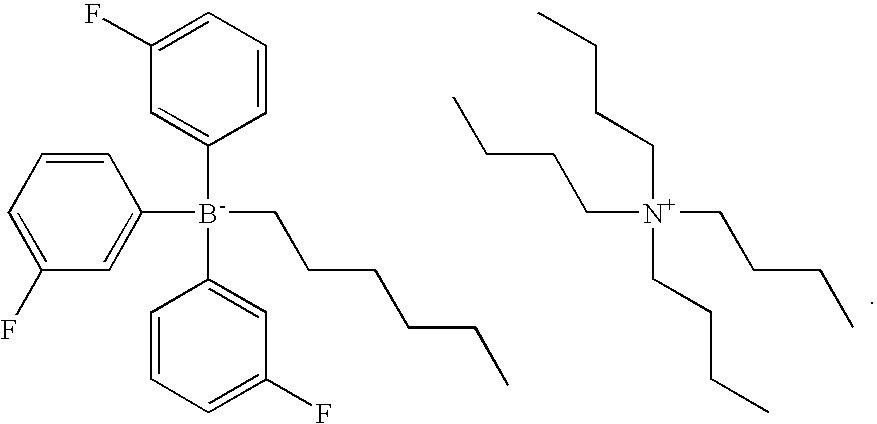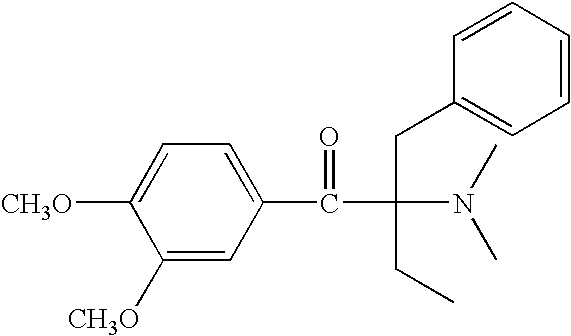Photoactivatable coating composition
a technology of coating composition and photoactivation, which is applied in the direction of coatings, transportation and packaging, synthetic resin layered products, etc., can solve the problem of too low cure speed
- Summary
- Abstract
- Description
- Claims
- Application Information
AI Technical Summary
Problems solved by technology
Method used
Image
Examples
example 1
Prepared were five photoactivatable coating compositions each comprising a photolatent base selected from the group of N-methyl nifedipine (base 1), N-butyl 2,6-dimethyl 4-(2-nitrophenyl) 1,4-dihydropyridine 3,5-dicarboxylic acid diethyl ester (base 2) and N-methyl 2,6-dimethyl 4-(4,5-dimethoxy-2-nitrophenyl) 1,4-dihydropyridine 3,5-dicarboxylic acid diethyl ester (base 3).
The photoactivatable compositions A, B, C, D, and E comprised 56 parts by weight (pbw) of Desmodur® N3390 (an aliphatic trimer of hexamethylene diisocyanate ex Bayer) and 27 pbw of trimethylol propane tris(3-mercapto propionate).
The weight percentage of the photolatent base varied between 0.1 and 0.4.
A50 μm thick film was drawn out onto a glass plate and exposed to UV A light (fluorescent lamps, type Cleo® ex Philips) at a distance of 10 cm (7 mW / cm2). The results of the experiments carried out at ambient temperature both in the dark and after 10 minutes' exposure are given in Table 1. The percentages quoted in th...
example 2
Example 1 was repeated, with the proviso that the photolatent base used was 2 parts by weight (pbw) of a tetrabutyl ammonium borate according to the following formula:
The photocurable compositions A and B comprised 50 pbw of Tolonate® HDT-LV (an aliphatic trimer of hexamethylene diisocyanate ex Rhône-Poulenc) and 27 pbw of trimethylol propane tris(3-mercapto propionate).
Composition A contained 1 pbw of sensitiser Quantacure® ITX (ex G. Lakes).
The results are mentioned in Table 2.
TABLE 2Composition (pbw)ABTolonate ® HDT-LV5050trimethylol propane tris(3-2727mercaptopropionate22Quantacure ® ITX1—curing time after exposure to UV A2>1minutesdaycuring time in the laboratory3 to 4>1hoursdaypot life>1>1dayday
According to the results mentioned in the above Table, in this case the presence of a sensitiser is a prerequisite for obtaining satisfactory results.
example 3
Example 1 was repeated, with the proviso that the photolatent base used was either 0.4 or 1.8 parts by weight (pbw) of an α-amino acetophenone, i.e. (4-morpholinobenzoyl)-1-benzyl-1-dimethylamino propane (Irgacure® 369 ex Ciba Specialty Chemicals).
The photocurable compositions A, B, and C each comprised 50 pbw of Tolonate® HDT-LV (an aliphatic trimer of hexamethylene diisocyanate ex Rhone-Poulenc) and 27 pbw of trimethylol propane tris(3-mercapto propionate).
Composition A contained 1.8 pbw of Irgacure® 369, composition B contained 0.4 pbw, and composition C contained 0.4 pbw and 0.1 pbw of dodecyl benzene sulphonic acid.
The results are mentioned in Table 3.
TABLE 3Composition, pbwABCTolonate ® HDT-LV505050trimethylol propane tris(3-272727mercaptopropionate)dodecylbenzene sulphonic acid——0.1Irgacure ® 3691.80.40.4curing time after exposure to UV-A111.5(minutes)curing time in the laboratory (minutes)454560pot life1.51.5>5 dayshourshours
According to the results mentioned in Table 3, in ...
PUM
| Property | Measurement | Unit |
|---|---|---|
| pressure | aaaaa | aaaaa |
| temperature | aaaaa | aaaaa |
| speed | aaaaa | aaaaa |
Abstract
Description
Claims
Application Information
 Login to View More
Login to View More - R&D
- Intellectual Property
- Life Sciences
- Materials
- Tech Scout
- Unparalleled Data Quality
- Higher Quality Content
- 60% Fewer Hallucinations
Browse by: Latest US Patents, China's latest patents, Technical Efficacy Thesaurus, Application Domain, Technology Topic, Popular Technical Reports.
© 2025 PatSnap. All rights reserved.Legal|Privacy policy|Modern Slavery Act Transparency Statement|Sitemap|About US| Contact US: help@patsnap.com



